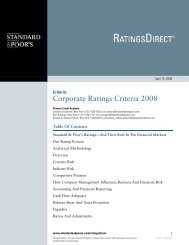European Infrastructure Finance Yearbook - Investing In Bonds ...
European Infrastructure Finance Yearbook - Investing In Bonds ...
European Infrastructure Finance Yearbook - Investing In Bonds ...
You also want an ePaper? Increase the reach of your titles
YUMPU automatically turns print PDFs into web optimized ePapers that Google loves.
Sensitivity and break-even analysis on each<br />
project is undertaken.<br />
This takes into account the specific cash-flow<br />
waterfall structure and repayment terms and<br />
conditions of senior and subordinated debt.<br />
Sensitivity analysis helps demonstrate and<br />
highlight potential downside thresholds under<br />
which subordinated debt may miss a payment of<br />
interest or principal. Stress tests, which are<br />
usually in the form of break-even analysis, assist<br />
in understanding whether a missed payment is<br />
due to any lock-up triggers or other distribution<br />
stoppers being breached and stopping cash<br />
flowing through to subordinated debt (and any<br />
dedicated debt-service reserve running out), or<br />
just the fact that there is not enough cash after<br />
the senior debt has been serviced irrespective of<br />
any distribution trap or stopper. Stress sensitivities<br />
are run on revenues, availability, prices, operating<br />
costs, capital expenditure, inflation, and<br />
refinancing spreads. Typically, the level of stress<br />
placed on subordinated debt is reconciled with the<br />
overall risk of the project and likelihood of a<br />
stress scenario occurring.<br />
Assessing the level and type of credit<br />
enhancement supporting subordinated debt.<br />
Such credit enhancement can take the form of<br />
equity, and project cash flows available after<br />
senior debt-service and liquidity reserves, usually<br />
in the form of dedicated debt-service reserves for<br />
the benefit of subordinated debt. If a<br />
subordinated debt instrument does not have its<br />
own debt-service reserve, it is likely to be more<br />
susceptible to default under stressed scenarios.<br />
Ability for senior debt to raise additional debt or<br />
offer security ahead of subordinated debt.<br />
Most projects allow limited other financial<br />
indebtedness to be raised and security granted to<br />
enhance the rating of senior debt. However, if this<br />
right is too broad, it may affect the level of<br />
subordination, which may change over time.<br />
What will influence the probability of default on<br />
subordinated debt?<br />
Apart from a project’s underlying operating and<br />
business fundamentals, which will be the major<br />
influence on the performance of a project, the<br />
probability of default of a project’s subordinated<br />
debt will be influenced typically by:<br />
STANDARD & POOR’S EUROPEAN INFRASTRUCTURE FINANCE YEARBOOK<br />
PROJECT FINANCE/PUBLIC-PRIVATE PARTNERSHIPS<br />
• The contractual and legal structure of a<br />
project, which usually incorporates a predefault<br />
cash-flow waterfall, cash lock-up<br />
and sweep triggers, a timeframe before cash<br />
is released from lock-up, and debt-service<br />
reserve accounts for senior debt; and<br />
• The terms and conditions of the underlying<br />
subordinated debt and any dedicated<br />
liquidity or debt-service reserve allocated for<br />
subordinated debt.<br />
Accordingly, key subordinated debt rating<br />
considerations include: how likely a project will<br />
go into distribution or equity lock-up; how long it<br />
will remain there; what happens to the trapped<br />
cash once in lock-up; and what type of credit or<br />
liquidity support (such as reserves) exist to lower<br />
default probability. If a distribution-trap<br />
mechanism does not last for an indefinite period,<br />
it could be argued that the resumption of debtservice<br />
payments on subordinated debt-depending<br />
on the project, scenario, and<br />
subordinated liquidity reserves--is likely to be<br />
certain. The analytical challenge is determining<br />
the duration of any under performance. We<br />
typically run stress scenarios for each project to<br />
analyze how long it would take for a rated<br />
tranche of subordinated debt to default under<br />
varying scenarios. Nonetheless, any significant<br />
deterioration in the performance of a project is<br />
likely to magnify the level of potential default on<br />
any subordinated debt.<br />
What will affect the recovery of<br />
subordinated debt?<br />
If a project suffers from poor performance and<br />
there is a missed payment of interest or principal<br />
on a project’s subordinated debt, a major<br />
determinant on the recovery prospects of<br />
subordinated debt is whether senior debt has also<br />
defaulted. If senior debt has not defaulted, it<br />
would prevent any recovery action of<br />
subordinated debt until senior debt is repaid or<br />
defaults. If this was to occur, there may be limited<br />
or zero recovery for subordinated debt.<br />
Should senior debt default or be repaid, factors<br />
that would influence the recovery prospects of<br />
subordinated debt include:<br />
• The nature of the default;<br />
• The type of security, collateral, and any<br />
first-loss protection;<br />
NOVEMBER 2007 ■ 119



